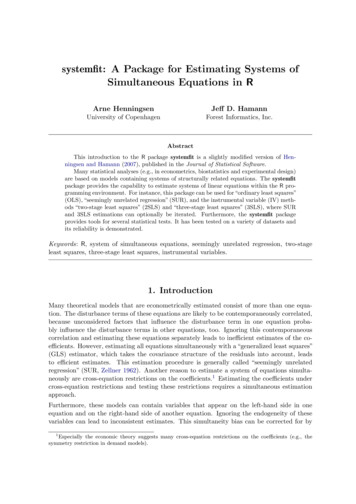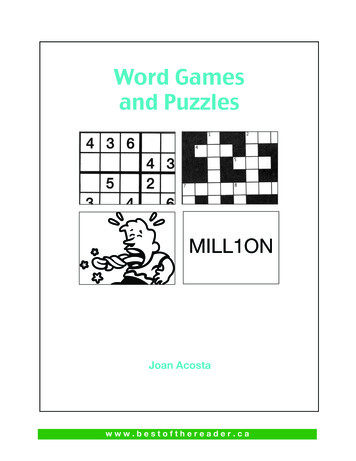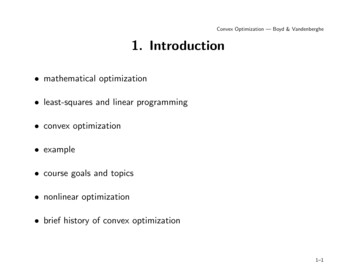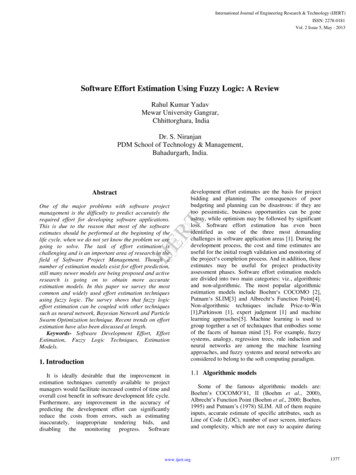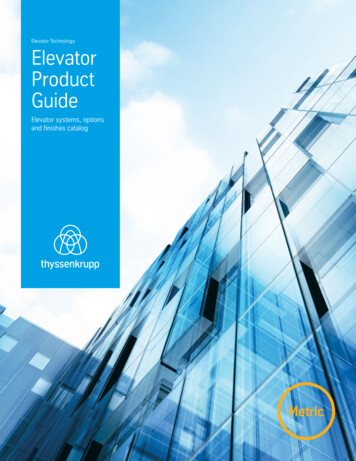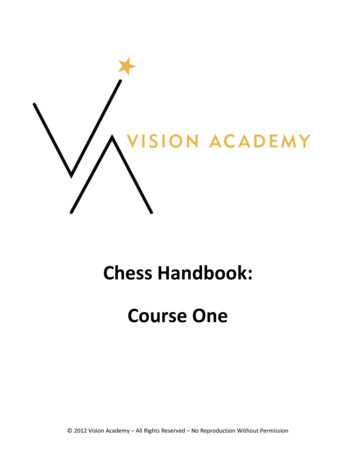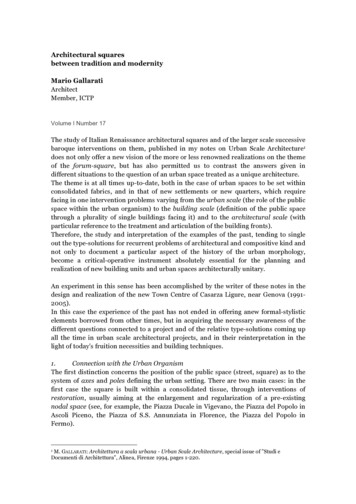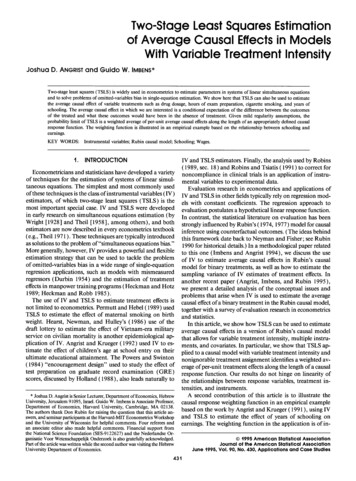
Transcription
Two-Stage Least Squares Estimationof Average Causal Effectsin ModelsWithVariable TreatmentIntensityJoshua D. ANGRISTand Guido W. IMBENS*Two-stageleastsquares(TSLS) is widelyusedineconometricsto estimateparametersin tion.WeshowherethatTSLS canalsobe tmentssuchas tedcausaleffectis a comesofthetreatedand whattheseoutcomeswouldhavebeenin tions,probabilitylimitofTSLS is a thelengthofan htingin an empiricalfunctionis illustratedexamplebasedon therelationshipbetweenandschoolingearnings.KEY WORDS: ages.1. INTRODUCTIONIV andTSLS c. 18) andRobinsandTsiatis(1991) elopeda variety noncompliancein clinicaltrialsis an ystemsoflinearsimul- mentalvariablesto experimentaldata.taneousequations.The simplestandmostcommonlyusedin econometricsEvaluationresearchand entalvariables(IV) IV andTSLS o-stageestimators,leastsquares(TSLS) is the els withconstantcoefficients.The regressionapproachtomostimportantspecialcase.IV and TSLS weredeveloped evaluationa hypotheticallinearresponsepostulatesfunction.in earlyresearchon simultaneousequationsestimation(by In contrast,thestatisticalliteratureon thers),andboth book inferenceusingcounterfactualoutcomes.(The her;seeRubinas solutionstotheproblemof"simultaneousbias." 1990forhistoricalequationsIn a V provideshowever,a powerfulandflexible to thisone (Imbensand Angrist1994),we discusstheuseestimationthatcan be usedto tackletheproblem of IV to estimatestrategyin esbiasin a ,as wellas howto estimatetheregressionapplications,suchas modelswithmismeasuredsamplingInvarianceofIV estimatesoftreatmenteffects.regressors(Durbin1954) and ,Imbens,and anandHotz we presenta anandRobb 1985).problemsthatarisewhenIV is usedto estimatetheaverageThe use ofIV and TSLS to estimatetreatmenteffectsis causaleffectintheRubincausalmodel,ofa Hebel(1989) used togetherofevaluationineconometricswitha surveyresearchTSLS to estimatetheeffectofmaternalsmokingon birth andstatistics.weight.Hearst,Newman,and Hulley's(1986) use oftheInthisarticle,weshowhowTSLS canbe usedtoestimatedraftlotteryto leffectsin a versionofRubin'scausalmodelserviceon civilianmortalityis anotherepidemiologicalap- ipleplicationofIV. Angristand Krueger(1992) usedIV to es- ments,In particular,andcovariates.weshowthatTSLS aptimatetheeffectofchildren'sage at schoolentryon their pliedtoa teeducationalattainment.The Powersand Swinton nonignorabletreatmentavassignmentidentifiesa weighted(1984) "encouragementdesign"usedto studytheeffectof erageofper-unittreatmenteffectsofa causalalongthelengthtestpreparationon graduaterecordexamination(GRE) responseOurresultsfunction.do nothingeon linearityofdiscussedscores,to therelationshipsbyHolland(1988), les,andinstruments.tensities,* JoshuaA secondcontributionofthisarticleis to illustratetheD. oW.ImbensProfessor,causalresponsein an mics,HarvardUniversity,MA 02138.Cambridge,andKrueger(1991), usingIVTheauthorsthankDon Rubinforraisingthequestionthatthisarticlean- basedon theworkbyAngristtheeffectof yearsof wers,participantsWorkshop and TSLS to nts.Fourrefereesand earnings.Theweightingintheapplicationis ofinfunctionan associateeditoralso rsityDepartment431? 1995 AmericanStatisticalAssociationJournalof the AmericanStatisticalAssociationJune 1995,Vol. 90, No. 430, Applicationsand Case Studies
432Journal of the American Statistical Association, June 1995terestbecausetherelationshipbetweenandearn- entsto enteringsis one ofthemostimportantin ghtingtodropoutofschoolwhentheyreachage 16.Thisformulacanhelp ontributinginducesa relationshipbetweenquarterofbirthand educato a particularestimate,and theformulaprovidesa causal nly oftheyearenterschoolat an olderage thando studentsusedin atan completedless2. APPLICATION:THEEFFECTOF COMPULSORY schoolingthanstudentswhoenterschoolat a youngerage.SCHOOL ATTENDANCEON EARNINGSIfstudents'ofbirthis correlatedwithearningsquartersolelyitis theoryofhumancapital(Becker1964)saysthatyearsin an earningsmentforschoolingequation.ofschoolingcan be treatedmuchthesamewayas an inOne wayto convertideaintoan estimationthisstrategyin physicalvestmenta rateofreturncapital,yieldingsomeis to comparetheeducationofpeopleborninandearningslikean s the"humancapitalearningstheorya semilogfunction,"in a laterquarter,Thisleadsto onon schoolingand othercopossibleIV es.An exampleis mple,calculationsWaldunderlyingbasedon a firstquarter/fourthquartercomparisonY o Xy pS ,) estimates( 1formenarelaidoutin Table 1. PanelA ofthetableshowswhereY is thelogofweeklyearnings,X1is resultstabulatedfromdata on thewagesand earningsyois a constant,ofa rowvectorofcovariates,S is meninthe1970Census,andPanelB showsresultsyj a thecoefficientp is theapproximateusingdata fromthe 1980Census.In bothdata sets,menreturnpercentageto a yearof schooling.Equation( 1) is bornin thefirstlessand haveslightlyquarterearnslightlysometimeswithan equationdescribingaugmentedhow ois relatedtothecovariates,schoolingco- esinschoolinggeneratesvariates,X2:a 70Censusand 8.9%usingthe1980Census.S 60 Xlbl X262 q7(2)Durbin(1954) stypicallyassumethata semilogarithmictheOLS estimateis nforearningsis a on.OrdinaryleastsquaresTable1. CompulsorySchoolAttendanceleadtobiased(OLS) appliedto( 1), however,estimatesmayofp evenifthetrueresponsefunctionis linear.Thereason(1)(2)(3)is thatschoolingis or example,theliteratureon schoolingandofyearofyear(1) - (2)hasdevotedconsiderableearningsattentionto theproblemPanelA: WaldEstimatesfor1970Census-Men Born1920-1929aof "abilitybias" in estimatesof the economicreturntoThisisa formofomitted-variablesbiasthatwould )ariseifmoreableindividualsin betteraccesstocapitalmarkets. Educationschooling,perhaps(.0192)The thosewith to educationearnings(.0196)moreschoolingIn termsof OLS est. ns( 1) and(2), abilityiscommontotheerrorterms, educationb(.0005)e and q, andso theseerrortermsarecorrelated.PanelB: WaldEstimatesfor1980Census-Men Born1930-1939One infeasiblesolutionto thisproblemis to conductanIn5.89165.9051-.01349(weeklywage)in whichschoolingis randomlyRanexperimentassigned.(.00337)dom assignmentwouldeliminatethecorrelationbetween eofa trueexperiment,a "naturalexperiment"Waldest. esthateffectivelydo the to educationOLS est. lesarevariablesrelatedtotheoutcome elythroughThe sample size is 122,223 in Panel A and 162,515 inPanel B. Each sample consists of itedStateswhohadpositiveearningsinample,in tworecentpapers,Angristand Krueger(1991, theyearprecedingthesurvey.The1980Censussampleis drawnfromthe5% hinteractswith 1970Censussampleis fromthestate,county,andneighborhoods1% samples.A detaileddeofthedatasetsis pulsoryattendancelawsandageat schoolentrytogen- scriptiontoeducationwasestimatedfroma bivariateregressionoflogweeklyearningsbTheOLS returneratevariationin yearsofcompletedschooling.Statecom- onyearsofeducationina sampleofmenborninthefirstandfourthquarters.a
433Angristand Imbens: Estimationof Average Causal Effectsof schoolingon a constantand threeis thediffer-stage"regressiona Waldand OLS s.estimatesbasedonsampling Columns(3)-(4) and (7)-(8) reporttheWaldestimatesarewithintheOLS s,(8% and 7% in thetwoCensus equationserroroftheOLS estimatesusedto condummies.The excludedinstrumentsseem entalin columns(4) and (8) includetheTSLS estimatesthattheOLS estimatesarenotbiased structtosupporta conclusionwith10 year-ofintheerrordummiesinteractedterm.(A detailedcasefor ear-of-birthandKrueger1991,whichalso birthdummies.This specificationthisclaimis madeinAngristin g effectsto controlforage s an instrumentquarteraresimilaranddifferTheOLS andTSLS estimatesis (Z'W) -'Z 'y, ofbirth.foran IV estimateThe generalformulaconformabletothematrix littleacrossmodelspecifications.Z isa matrixofinstrumentswhereX1and S, andy is aofregressors,W, withrowsincluding3. THEAVERAGECAUSALEFFECTvariable.Becauseon thedependentvectorofobservationsTREATMENTOF A VARIABLEincludesX1is assumedtobe uncorrelatedwithe,Z typicallyX1and a singlevariablenotin tion(1) is a structuralFor sumptionsincludequarterofbirth.in (2). ehavior,IV to be consistent,Z mustbe asymptoticallyuncorrelateda causalrelationshipintheRubin(1974) sense.In thisseclimitof(Z 'W/ tionwe sultsthatgiveIV and TSLS estimates(n is thesamplesize).n) mustbe on(1) causalbasedonthesameidea dividualwouldearnYjifhe orshehadj yearsofschoolingAnalternativeestimationstrategyIV or Wald forj 0, 1, 2, . . ., J. It is usefulto imaginethata fullsetthreedifferentis TSLS. Thereare potentiallyestimatesthatcould be ughonlyoneisobserved.ofYjexistsA TSLS estimatoravail- The setof Yjforone personis theS outcomesand treatmentregressingable on quarterofbirthis calculatedby firststatusofotherpeople.Rubinhasincludedinthe calledindependenceon all covariatesregressor)(theendogenousof thesepotentialor counterfactualexcluded outcomesinstrumentsequation,X1,andon all tacrossfromtheequation,X2-in thiscase tof(SUTVA) assumption.is to es- and SUTVA arecommonlyThesecondstagein theTSLS proceduredummies.literassumedin thestatisticstimatetheseareatureon causality(e.g.,Holland1986),althoughetal. 1995),weElsewhere(Angristassumptions.nottrivialpY 0 X1Y PA alin an IV context.and sumptionsregressionwhere3'is thefittedvaluefromthefirst-stagethenotionof Providedthatwe are willingto entertainInTSLSbeinterpretedcanv-{ep[S -] 1}. iveoutcomes,wheretheinstrumentsareXI and3S(Theilas an ver1971), or as an efficientlinearcombinationofalternativeYj-Y ausalIV ofTableColumns(1 )-( 2) and(5 )-( 6)reportwhentheyhaveprobusing (1) as havinga causalinterpretationTSLS estimatesof Equation( 1) withoutcovariateslimitequalto a weightedusedto abilityaverageofE[ Yj -Yj- I] forbothCensusdata sets.The excludedinstrumentsInofinterest.orsubpopulationsin thesecolumnsare three allj insomesubpopulationtheTSLS es.is,quarter-of-birthvaluesfroma "first-is randomlyassigned,thenE[ Yj -Yj I ] can be consistentlysionsofthelogweeklywageon fittedTable 2. TSLS Estimatesofthe Returnto SchoolingBorn 1930-1939, 1980 censusBorn 1920-1929, 1970 censusEducationYOB dummiesx2(dof)Sample 004)no.063(.016)no2.4 (2)247,199yes36.0 (29).103(.020)no2.9 (2).071(.0003)yes.089(.016)yes25.4 (29)329,509fromOLS and TSLSNOTE: Each sample consists of men bom in any quarterin the UnitedStates who had positiveeamings in the year precedingthe survey.The table reportscoefficientsincolumns4 anddummies.The excluded instrumentsincolumns2 and 6 are threequarter-of-birthregressionsof the log weeklywage on years of completedschooling.The excluded instrumentstest statistic.orthogonalitydummies.The X2 statisticis an instrument-error8 are threequarter-of-birthdummiestimes 10 year-of-birth
Journal of the American Statistical Association, June ssumptiontheaveragebysubtractingestimatedlevelj - 1 fromtheaverageresponseforwithtreatment (Y1 - Yo)So]E[Yo (Y1 - Yo)S] -E[Yolevelj.)withtreatmentindividualsWe defineSz E {0, 1, 2, . ., J} to be thenumberof E[ (Y-YO)(S1 - SO)]. (4)onbya studentconditionalyearsofschoolingcompletedS1 - So canberestrictions,additionalimposingWithoutZ. AswithYj,Sz is assumedquarterofbirth,thestudent'swhoindividualsto existforeachvalueofZ foreachperson,eventhough equalto 1,0, or -1. A valueof 1 indicatestheinstrument(i.e.,highschoolbytwoin- areinducedtograduateonlyone Sz is observed.Thissetupincorporatesthosebyal- beingbornin a latequarter),a valueof0 indicatesnovationsto theoriginalRubin(1974) frameworkanda valueof-1 instatusis 978) and Robins(1989a, b) dicatesthosewhoare induced dropout eat- beforealso discussedcausal inferencements,and Robins (1989a), Robins and Greenland E[(Y - YO)-(S1 - So)](1992) and Holland(1988) used thenotionof counter E[Y1 -YoSSo 1] Pr[SI - So 1]thesestatus.As faras weknow,however,factualtreatmentin an IV or TSLSideas have not been used previously-E[ Y1-Yo IS1-SO -1I Pr[S-SO -1]Iframework.Initiallywe assumethatZ is codedto takeon onlytwo(5)ofbirth.firstorlaterquartersvalues,0 and 1,indicatingSostatusis unaffectedbytheinwhoseschoolingbyan indi- Individualsthatwouldbe attainedis theyearsofschoolingtocomparisonsdo ling strumentquarter,vidualborninthefirststatus.But thegroupifhe or she of averageoutcomesby instrumentthatwouldbe attainedbythesameindividualandincludesboth "switchers-in"For each personin the that does contributewereto be bornin ituationhaveYo, is*Z S0Z)yearsS1 (1thequarterofbirth,S Szbutthesizesofthegroupofswitchers-inOurprincipal itiveforeveryoneandY Ysisearnings.ofcompletedschooling,in ndoutcomesofallpotentialofYj)is thatZ is aduating(effectthisAs a a forthoseinducedtoon covari- a be trueonlyafter2 and Pr[S1 -So -1] 3 out.Ifdrop1]Pr[ -SoS1sometimesates.(In fact,theneedto controlforcovariateson Z is zero,in Y conditionalwehave thentheaveragedifferencemotivatestheuseofTSLS insteadofIV.) Formally,0 he mostcommonwayto getaroundthisproblemisI (Independence). The randomvariablesS0, simplyAssumptionunittreatmenteffect,toassumea constantYj- YjofZ. a, forall j and all individuals.S1, Yo,Y1,. . ., Yj arejointlyindependentThis is theassumption1 re- underlyingIn cusinglinearregressionapplicationsother models,as wellas theapplicationon earningsofbirthhasno effectvariablesquiresthatquarterofinstrumentalof techniquesThisis themeaningon schooling.thanthroughitseffectand Hebel(1989). In hiscommentbyPermutta naturalexperimenton Holland's( 1988)discussionLeamer( y,ofschoolingon earn- pointedoutthatin e usedto estimate1 can alsobe viewedas a rumentalings.AssumptiontheproblemX2,areun- inferencethattheinstruments,oftheassumptionsis straightforward.versioninthisinEquations(1) he andi, ntheimpactofdeviations articleweimposea nonparametricetal. (1995) discussed(2). Angristis thatof Z. Thisrestriction1 on IV estimatesinthebinarytreatmentdeterminingS as a functionfromAssumptioneitherSI - So 2 0 or SI - So 0 foreveryone.If in thecase.S1 - So 2 0, then(5) becomestreatmentexample,It is importantto notethatoutsidea linearregressionbinaryaloneis notusuassumptionframework,theindependenceef- E [(Y - YO) (SI - SO)]a fect.Thispointis easiestto seein a simpleexamplewhere E[Y1-Yo I11-So 1] *Pr[S1-So 1]. (6)versusS isbinaryhighschoolgraduates(perhapsindicatingE[ Y1 - YoIS - So 1], isThe conditionalexpectation,valofoutcomesA (LATE;whatwehavecalleda ensandAngrist1994).LATE istheaverageZ OIE[YI Z 1I-E[YIbystatusis affectedforthosewhosetreatmentoftreatment( i.e.,forthoseforwhom51 1 andSO 0) .theinstrument 11 E[Yo (Y o-)S1IlZis y,(3) (givenindependence)- E[Yo (Y1 -Yo)SoIlZ 0].*identified.forLATE to be-
Angristand Imbens: Estimationof Average Causal Effects4352 (Monotonicity).AssumptionWithprobability1,either Pr{I[SI 2 1] - I[So 2 1] 1} Pr(S 2 1 So) andPr{I[SI ? 2] - I[SO ?2] 1} Pr(S 2 2 SO).So 0 or SI - So 0 foreach person.The requirementthat Pr(SI 2 j So) 0 forsome jThisassumptionhas ,mustaffect(1989a), whoshowedthatit doesnotsharpenboundsfor ffects,and byPermuttand S. Also,notethatin theproofofTheorem1,S is assumed0 andJ.Itis enough,valuesbetweenHebel(1989) in thecontextofa regressionmodelforthe totakeon onlyintegerofnumberthatS be boundedandtakeon a finiteIn thesmoking however,ofmaternalon birthweight.effectsmokingantismok- rationalvalues.Thenone can alwaysuse a lineartransformeansthata randomizedexample,monotonicityvaluesonlybetweenIn theschooling verincreasessmoking.ofS does nothaveanymeansthat,becauseofcompulsory0 and J. A f(7) and multiplieson thenumerator2-4 completeat effectattendancelaws,peoplebornin quartersamountsThusthelineartransformationhad natorbya constant.as theywouldhavecompletedleastas muchschoolingis meaintensitytheunitsin whichtreatmentto changingtheybeenbornin thefirstquarter.unob- sured.2 is notverifiable,becauseitinvolvesAssumptionbecauseit showsthatin a wideTheorem1 is importantNevservedvariables(i.e.,onlyoneofS1orSOis tances,formultivaluedtreatmentsertheless,(J 1), AssumptionvarietyForof Yj Yj .example,theofthedistributiondistributionfeatures2 archplausibleappearsassumptionfunction(CDF) ofS givenZ 1 and theCDF ofS given monotonicityin? and1990)lottery(e.g.,AngristZ 0 shouldnotcross,becauseifSI SOwithprobabilitysignsbasedon thedraftor1,thenPr(SI ?1j) Pr(So ?j) forallj. ThisimpliesPr(S designsbased on has discussedjlZ 1)? Pr(S jlZ 0) orFs(jlZ 0) ? Fs(jIlZ intention-to-treatis also meThisassumption 1), whereFs is theCDF ofS. We investigate(1988).andHollandthisimpli- (1984)models commonlyinthelatentindexsatisfiedIf J 1 and chanicallycationin Imbensused econometricsthetreatmentis binary,thentheCDF's cannotcross.f as eticalresultofthearticleis nowgivenfor Werefer?ofcausalaverageaweightedcaptures(ACR). Thisparameterthecase whereS, So 0.whoseinforthoseto a unitchange treatment,1and2 holdand responsesTheorem1. SupposethatAssumptionsThebytheinstrument. weighttreatmentstatusis affected1 j SO) 0 forat leastonej. ThenthatPr(SIto theto theaverageof Yj - Yj is umberofpeoplewho,E[YI Z 1]-E[YI Z 0]lessthanj unitstoj ormoreunits.ThisfromtreatmenttheirE[SI Z 1] - E[SI Z 0]SI-proportionis Pr(SIJ2j So). In theschoolingexample,thisofpeoplewho,by accidentofbirth,areis theproportion, E[Yj -Yj-l I S, j SO]9 ,(7)wjyearsofyearsor fractionaltoadditionalcompleteinducedj ation,involvesdatabecausemembershipfromthebe identifiedPr(SI j SO)treatmentstatus.counterfactualunobservedzJ 1 Pr(SI i SO)A refereemade thepointthatalthoughtheACR is aThis impliesthat0 wj 1 and IJ 11 1, so that is a ,treatmenteffect.weightedaverageper-unitwhois f ducedtograduateProofofthetheoremis givenintheAppendix.highschoolbyhavingbeenbornin a latefromEquations quarter,thesamelinesas gradehadheour earlierresult(Imbensand orshebeenborninthefirst(3)-(6) and to vidualsforwhomPr(SI 2 12 SO).ButanyintensitiesA simplifiedexamplewiththreetreatmenthelps onewhois inducedtograduatehighschool,butwouldhaveto understandthemoregeneralresult.SupposethatS can otherwise10thgrade,willbe in thepopuonlycompletedbe equalto 0, 1,or2. We canwriteforwhomPr(S 2 12 SO) and forlationofindividualswhomPr(SI ? 11 So).Y YO (Y1 - YO)I[S 2 1] (Y2- Y1)I[S 2 y,foreventA. A version tionofthesampleto go from10 to 12 unitsoftreatmentwhereI[A ] is theindicatorfunctionofEquation(4) forthiscaseis'ThentheACR can be writtenotherwise.buthas no effectsumoftwoastheaverageeffects,single-unitE[YIZ 1]-E[YIZ 0] E[(Y1 - YO) (I[S111- E[(Y2 -Y1) (I[51?2]2-I[So[So 2 1D)]I? 2])].ByvirtueofAssumption2, I[S1 2 1] - [So 2 1] andI[S12 2] - [So 2 2] mustbothbe either1 or 0. Therefore,E[Y12Y1 11S1 2 12 SO] -EY Y1- oIlS1 2 11 So],
436Journalofthe AmericanStatisticalAssociation,June 1995whatreallyis identifiedcan be consistentlyestimatedfunctionalthoughis E[Y12 -Y1o ISI ? 12, Thustheweighting11 S0]. In theschoolingand otherexamples,however, fromthe differencebetweenthe empiricalCDF's of Smostindividualswouldprobablyinan over- givenZ.notbeinvolvedlap ofthissort,becausetheinstrumentwouldtypicallybe4. MULTIPLEINSTRUMENTSAND MODELSexpectedto cause no morethana rentBecausedifferentinstruments3.1 IncorrectlyCoded BinaryTreatmentsin thedefinitionoftheACR,thediscusweightingschemesan eorem1 has a simplecorollarythatcan be usedtooff interpretin modelswherea differ. typicalapplicationtreatmentis incorrectlyas a binaryparameterizedtreatment.ever,imposesa constant-treatment-effectmodelin whichForexample,PermuttandHebel( 1989)discussedconditions In thiscase,alterYi Yj I a forallj andall ssumed nativeofsmokingestimatesofthesamea canbeinstrumentalvariablesthatall thatmattersforhealthis edintoa SLS effecton atinggraduation sarenonlinearfunctionsofan ,RosenandWillis1979).We explorethisquestionforthecasewhereK mutuallyarecombineda ntofinterestis assumedtobe an instrumentstionofS, sayb I(S 2 1),forsome1 1? J.Then,givenindicatorvariables.TSLS usingK orthogtuallyorthogonal1 and 2,Assumptionsonalindicatorscan be thoughtofas a meansofexploitingE[YIZ 1]-E[YIZ O]X dZ (e.g.,quarterofbirtha singleK 1-valuedinstrument,E[bI Z 1]-E[b Z O]takeson fourpossiblevalues).Moreover,a entheinstrument.pectationin homoE[SI Z 1]-E[SI Z O]TSLS estimatorThisleadsto cconstantregressionE[bj Z 1]-E[b Z O](Newey1990).j SO), J I Pr(SI2 showsthattheTSLS estimatorbyTheoremconstructed1.Pr(SI 2 1 So)dummyvariindependentusinga constantplusK linearlyhas probabilitylimitNotethattheonlysituationwhere I1 is whenthe ables, dk I(Z k), as eopletoswitchfromS /- 1 to S 1. Thus whena variabletreatmentis 1k,k-l, whereastheestimateE[YIZ k]I-E[YIZ k- 1]incorrectlyparameterized binary, resultingtendsto be too largerelativeto theaverageper-uniteffectPick-iE[SIZ k]-E[SIZ k-1]oftheresponsefunction.On theotherhand,alongthelengthBecauseeachfklk-I is a weightedaverageofpointson thethesignoftheACR is stillconbyvirtueofmonotonicity,theTSLS ted.sistentlyfunctoa weightedaverageofpointson thecausalresponsetion.3.2 Estimationofthe ACR and the WeightingofZ be orderedsuchthat/ mLetthepointsofsupportFunction -impliesE[SI Z I] E[SI Z mi]. Note that using KA naturalestimatorofd is itssampleanalog.Thisesti- dummies,inTSLS estimationdk I( Z k),plusa constantmatoris an applicationofWald's( 1940)groupingmethod is the same as ghtlines,wherethedatahavebeengrouped E[S IZ] plusa constantas instruments.We thenhavetheDurbin( 1954)appearstohavebeenthe followingbytheinstrument.theorem.to pointoutthattheWaldestimatorfirstis also an instru2. SupposethatE[S IZ] and a constantareTheoremmentalvariablesestimator.of1, ininstrumentalusedto constructvariablesestimatesThe ACR weightsin Theorem1 can be estimatedusingtheequationa randomsampleof(Y, S, Z) becausePr(S1j S0) Pr(S Y -Y fZS e.j) - -Pr(S0 2 j)limitThe resultingestimatehasprobabilityPr(S0 j) -Pr(S1 j) Pr(SjIZ 0)-Pr(S jI
KEY WORDS: Instrumental variables; Rubin causal model; Schooling; Wages. 1. INTRODUCTION Econometricians and statisticians have developed a variety of techniques for the estimation of systems of linear simul- taneous equations. The simplest and most commonly used of these techniques is the class of instrumental variables (IV)
